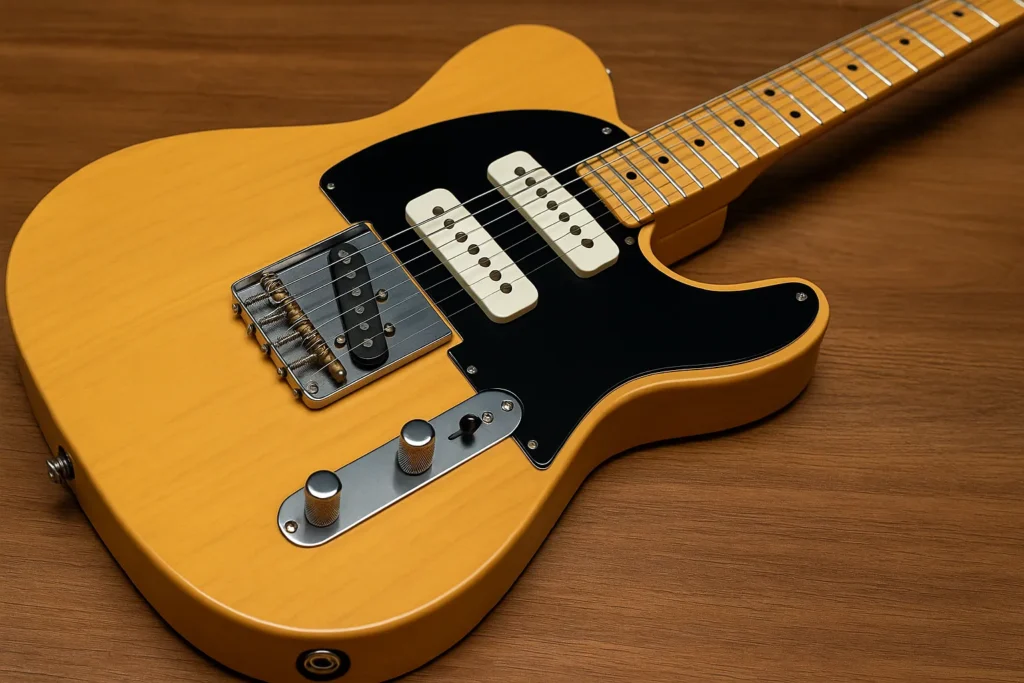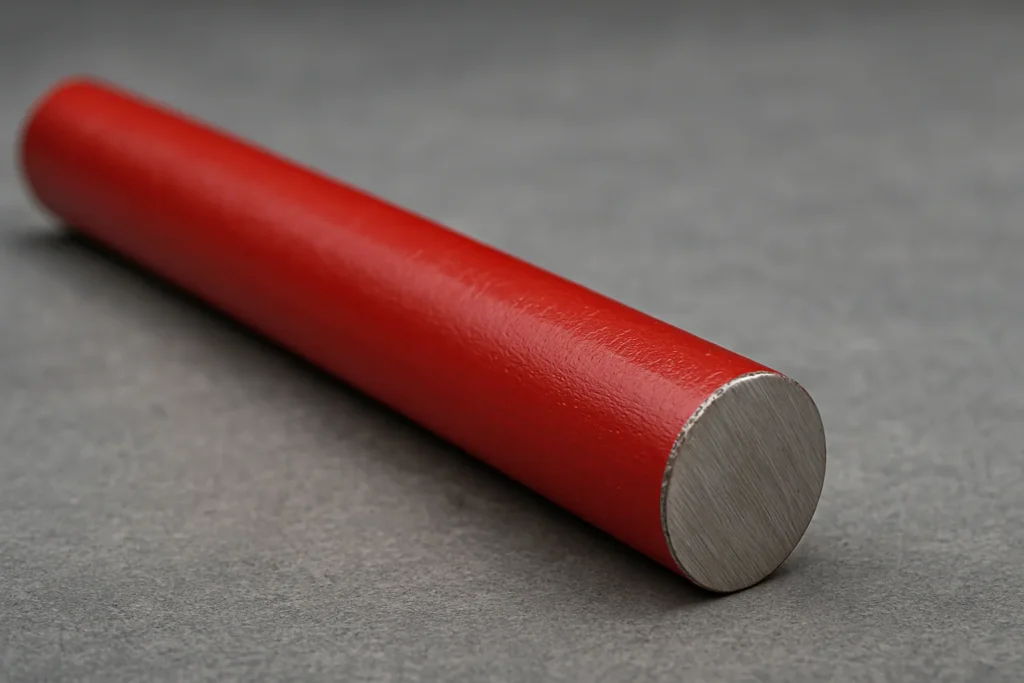If you’ve ever played a Telecaster, you already know why it’s one of the most iconic guitars out there. Simple, reliable, and full of twang. But here’s the thing — once you start modifying a Tele, the possibilities open up in ways you might not expect. One of the most interesting mods players experiment with is adding a third pickup and giving each pickup its own volume control. That’s what people mean when they talk about a “tele 3 pickups 3 volumes” setup.
Why would anyone go this route? For starters, it gives you more tonal flexibility than a stock Tele can offer. You can blend pickups in unique ways, adjust volume balances on the fly, and shape your sound in ways that just aren’t possible with a single master volume. On top of that, it’s a wiring challenge that teaches you a lot about how guitars actually work. In this article, we’ll dig into what this setup is all about, why players love it, and how you can make it work for your own guitar.
Short Definition:
A tele 3 pickups 3 volumes setup adds a third pickup to a Telecaster and gives each pickup its own volume control, offering players versatile tone blending, unique wiring options, and maximum control over their guitar’s sound.
Understanding the “3 Pickups, 3 Volumes” Telecaster Setup
So what does this mean in practice? A standard Telecaster comes with two pickups — one in the bridge, one in the neck — and usually a three-way selector switch plus a single volume and tone knob. Pretty straightforward. But when you add a middle pickup and assign each pickup its own volume knob, the wiring layout changes completely.
With this setup, you don’t just flip between neck, middle, and bridge. Instead, you can blend them together in countless combinations. Want the neck and bridge at full volume while rolling the middle down just halfway? Easy. Or maybe you like the middle pickup sitting quietly underneath the bridge bite for a thicker rhythm sound — also doable. That’s the beauty of independent volume controls: you decide how each pickup speaks in the mix.
Of course, this also adds some complexity. More controls can mean more things to adjust mid-song. Some players love the versatility, while others feel it gets in the way of simplicity. If you’re the kind of guitarist who likes experimenting with tones and crafting subtle blends, the “tele 3 pickups 3 volumes” layout might be exactly your kind of project.
Pickup Choices for a 3-Pickup Telecaster
Here’s where things get interesting. Deciding what pickups to use in a three-pickup Tele build is half the fun. You’re not locked into just three single coils — although plenty of players stick with that for a more traditional sound.
Some go with three single coils to create something close to a Strat-style tonal range but with the body and feel of a Telecaster. Others drop in a humbucker in the neck or bridge for added warmth or bite. Mixing a Tele single coil with a mini-humbucker or even a P90 can give you a huge tonal palette. That’s why a lot of custom shop and DIY builds experiment with pickup combinations you’d never see in a stock Fender catalog.
The important thing is to think about balance. You don’t want one pickup to overpower the others. For example, a super-hot humbucker in the bridge might drown out vintage-style single coils in the neck and middle. Matching output levels is key if you want smooth transitions and useful blending across the three volume controls. When I tried a setup with a humbucker at the neck and two single coils, I found myself constantly tweaking volumes to keep things balanced — but the tones I got out of it were worth the effort.
Wiring Basics for 3 Pickups and 3 Volumes
Now let’s talk wiring. At the core, “3 pickup 3 volume wiring” means each pickup has its own dedicated volume pot. Instead of running all three pickups into a single master control, the wiring sends each one to its own knob before hitting the output.
There are a few ways to do this. Some players keep a simple three-way switch, which lets you toggle pickups while also blending volumes. Others prefer a five-way switch, similar to a Strat, which opens up even more combinations. You’ll also see wiring variations like “guitar wiring diagrams 3 pickups 1 volume, 1 tone” — that’s a simpler setup with just one overall volume. But if your goal is maximum control, independent volumes are the way to go.
Here’s the challenge: more controls also mean more chances for interference, grounding issues, or tone loss. Choosing the right pot values (250k vs 500k), using good shielded wire, and keeping your solder joints clean makes a huge difference. Think of it like plumbing — if one connection leaks, the whole system suffers. Get it right, though, and the tonal options will blow your mind.
Practical Wiring Walkthrough
If you’re thinking about wiring a Tele with three pickups and three volumes, here’s the good news: it’s not as intimidating as it looks. You’ll need a soldering iron, a wiring diagram, and a little patience. The trick is to plan everything before you touch the guitar. I always recommend sketching your wiring out on paper or printing a proper 3 pickup Telecaster wiring diagram. That way, you’re not trying to figure things out while balancing a hot soldering iron.
Here’s a simple step-by-step approach:
- Lay out the components – Pickups, pots, switch, and output jack.
- Wire each pickup to its own volume pot – Make sure you follow the diagram closely.
- Connect the outputs of each volume pot to the switch – This is where you decide if you’re going with a 3-way blade, a 5-way switch, or mini toggles.
- Wire everything to the output jack – Keep your solder joints clean and avoid cold connections.
- Test before closing up – Plug in and check each pickup individually, then blend them to make sure everything works.
One real-world tip: keep your wires neat and trimmed. Messy wiring not only looks bad but can introduce noise or cause grounding issues. I once had a Tele with a 3 pickup 3 volume wiring harness where a loose wire would ground out whenever I touched the control plate. A quick tidy-up fixed it, but it reminded me how much clean wiring matters.
Tone & Control Strategies With 3 Volumes
Here’s where the magic happens. Three independent volume knobs give you more than just “on” or “off” for each pickup. You can blend them like ingredients in a recipe. Want a fat, bluesy sound? Roll the neck up full, bring in a touch of middle for body, and leave the bridge low. For funk, you might keep the bridge bright and crisp, then add just enough middle to thicken it up.
Some players love to use this setup like a built-in mixer. For example, I had a friend who ran the bridge and middle at full blast, then kept the neck low for fills. When he wanted to jump into a solo, he just cranked the neck volume and boom — instant lift without touching his amp.
And if you like experimenting, the options are endless:
- Neck + Middle: Warm and round, great for jazz or clean chords.
- Bridge + Middle: Punchy rhythm sound that cuts through a mix.
- All Three: Thick, layered tones that can sound massive with overdrive.
- Solo Pickup: Roll the other volumes off and spotlight one pickup for clarity.
Add advanced mods like coil splits or phase reversal, and suddenly your Tele can sound like multiple guitars in one. Pair that with effects pedals, and you’ll spend hours just exploring.
Example Wiring Diagrams & Case Studies
It’s one thing to talk theory, but seeing wiring diagrams really helps. A basic schematic for 3 pickups with 3 volumes and a 3-way switch shows each pickup running to its pot, then all three feeding the switch before heading out to the jack. It’s clean and makes sense once you see it on paper.
If you want even more combinations, a 5-way switch is worth considering. That gives you familiar Strat-style positions but with the Tele’s unique character. Some players even skip the switch altogether, relying only on the three volumes to blend pickups. It’s less conventional, but it works surprisingly well once you get used to it.
Let me give you a quick case study: I wired a friend’s Tele with three single coils and three volumes, no tone control. At first, he worried about losing the tone knob, but once he started blending pickups, he realized he didn’t miss it. By rolling down the neck volume just slightly while keeping the bridge and middle high, he got tones that felt smoother than using a tone knob. It’s a reminder that wiring choices aren’t about rules — they’re about discovering what works for you.
Troubleshooting & Fine-Tuning
Now, let’s be real. Any time you dive into custom wiring, issues pop up. The most common one with three volumes is noise. If your solder joints aren’t solid or your guitar isn’t properly shielded, you’ll hear hum. Using shielded wire and checking all grounds usually solves the problem.
Another challenge is volume interaction. Sometimes, rolling down one volume affects the others. This can happen if the wiring isn’t isolated properly. The fix is to make sure each pot is wired in a way that prevents unwanted bleed. Double-checking your diagram before you solder saves headaches later.
Output balance is also key. If one pickup sounds way louder than the others, you might need to swap it out or adjust pickup height. I remember testing a setup where the bridge single coil was so hot it completely buried the neck and middle. Lowering the bridge pickup and raising the others balanced things nicely. Small adjustments like this can completely transform the playability of your guitar.
Comparing Layout Options
The big question is: do you really need three volumes? Some players prefer a master volume plus separate tone and blend controls. That way, you get simplicity on stage without losing flexibility. For example, “guitar wiring diagrams 3 pickups 1 volume, 1 tone” is a more streamlined approach, and it might be perfect if you don’t want to juggle three knobs while performing.
Independent volumes, though, are all about fine control. They shine when you want to create subtle blends. Imagine recording in the studio and being able to dial in a sound that’s 40% bridge, 30% middle, and 30% neck. That level of precision isn’t possible with a single master volume.
It really comes down to your playing style. If you want simplicity and speed, go master volume. If you want maximum tone-shaping power, three volumes are worth the extra learning curve.
Advanced Mods & Creative Options
Once you’ve got the basics working, you might feel like experimenting further. That’s when the real fun begins. Adding push-pull pots for coil splits or phase reversal opens up tones that can surprise even seasoned players. With three pickups, you can wire one to flip out of phase with another, creating a thinner, almost hollow sound that’s perfect for funk or indie rock.
Another creative option is wiring 3 humbuckers with a 5-way switch. Even if you stick to single coils, this kind of switching unlocks sounds beyond what most players expect from a Telecaster. And if you’re really adventurous, you can add blend knobs or mini-toggles to control specific combinations. It may sound complicated, but once you’ve played around with it, you’ll see how these mods turn your guitar into a tonal playground.
The best part is that none of this is permanent. Don’t like a certain wiring choice? Unsolder and try something new. Guitars are meant to be experimented with, and the “tele 3 pickups 3 volumes” build gives you a perfect canvas to explore your creativity.
Pros & Cons Summary: Is This Setup Right for You?
Let’s break it down clearly.
Pros
- Wide tonal range and blend options.
- Independent control over each pickup’s output.
- Perfect for studio work where subtle differences matter.
- Teaches you a lot about wiring and guitar electronics.
Cons
- More complex wiring = more chances for mistakes.
- Steeper learning curve on stage (takes time to master three volumes).
- Can get noisy if not shielded properly.
- Not everyone needs that much control — sometimes less really is more.
So who should try this? If you love experimenting, recording, or just want a unique guitar that doesn’t sound like anyone else’s, this setup is worth the effort. But if you’re a gigging player who just wants simple, reliable controls, you might be happier sticking with a master volume or a traditional Tele layout.
Real-World Examples & Artist Inspiration
The three-pickup Telecaster isn’t just a bedroom mod. Fender has produced models like the Nashville Tele, which adds a middle pickup for extra flexibility. Some players even mod those further by assigning separate volumes. And if you look at custom shop builds, you’ll see triple-pickup Teles popping up regularly.
I remember seeing a session guitarist in a blues band using a Tele with three pickups and three volumes. He treated it like a mixing console — riding the knobs during songs to change his blend. It was fascinating to watch, and it made his tone incredibly dynamic compared to other players sticking to standard wiring. That’s the kind of inspiration that shows why this layout continues to attract curious guitarists.
Maintenance & Long-Term Care
With more wiring comes more responsibility. A triple-volume setup needs occasional checkups. Pots can get scratchy, solder joints can loosen, and extra wiring means more chances for something to go wrong. Cleaning your pots with contact cleaner once in a while helps keep them smooth.
Also, keep an eye on pickup height. Since blending is such a big part of this setup, even a small adjustment can change how your guitar feels. Don’t be afraid to tweak until the pickups balance out. Finally, if you ever notice noise creeping in, check the shielding. Copper tape in the control cavity can work wonders for keeping your signal clean.
Comparison Table
| Feature | Standard Telecaster (2 pickups, 1 volume) | Tele 3 Pickups 3 Volumes Setup |
| Number of Pickups | 2 (neck + bridge) | 3 (neck + middle + bridge) |
| Volume Control | 1 master volume | 3 independent volumes |
| Tone Options | Limited, straightforward | Vast blending possibilities |
| Switching | 3-way switch | 3-way, 5-way, or no switch |
| Complexity | Beginner-friendly | Advanced/mod-heavy |
| Best For | Classic Tele tones | Tone explorers, custom builds |
Quick Step-by-Step Wiring Guide
- Install the third pickup (usually in the middle position).
- Connect each pickup to its own volume pot.
- Wire all volume outputs to the switch (3-way or 5-way).
- Connect the switch to the output jack.
- Test the wiring, fix any hum or grounding issues, and adjust pickup height.
FAQs
What Telecaster has three pickups?
The Fender Nashville Telecaster is a well-known model with three pickups. Many players also create custom 3 pickup Telecasters for more tonal options.
Why do Teles sound better than Strats?
It’s subjective, but many players say Teles sound “better” because of their simplicity and bright, punchy tone. Strats are smoother and more versatile, while Teles cut through a mix with raw character.
What pickups did Jimmy Page use in his Tele?
Jimmy Page’s famous “Dragon Telecaster” originally had stock single coils, but he later modified it with a Gibson humbucker in the neck position for heavier tones.
What is the point of a Thinline Telecaster?
The Thinline Telecaster has a semi-hollow body, making it lighter with a warmer, more resonant tone compared to solid-body Teles. It’s great for players who want comfort and a more open sound.
Do you need a tone knob with 3 volumes?
Not necessarily. Many players find that blending three volumes creates enough tonal shaping without a separate tone knob. But you can always add one if you prefer.
Conclusion
At the end of the day, a “tele 3 pickups 3 volumes” build is about pushing the boundaries of what a Telecaster can do. It’s not for everyone, but if you enjoy experimenting and want more tonal control than a standard setup offers, it’s a fantastic project.
Here’s the takeaway: three volumes give you the power to shape your tone in real time. You can blend, balance, and discover sounds that no stock guitar delivers. Sure, it takes a little effort to wire up and even more practice to master, but the payoff is worth it.
So if you’ve been thinking about modding your Tele, maybe it’s time to grab a soldering iron, a wiring diagram, and start exploring. Who knows — the sound you’ve been chasing might be hiding in that third pickup.
Disclaimer
This article is for educational and informational purposes only. Guitar modifications such as wiring changes should be done carefully. Always use proper tools, follow diagrams, and if you’re unsure, consult a qualified guitar technician or luthier. We do not take responsibility for any damage or issues resulting from DIY modifications.

Hi, I’m Bilal, the founder of outofmagazine.com. I love sharing fresh ideas, stories, and helpful insights on all kinds of topics that spark curiosity. My goal with this site is simple—to create a space where readers can find inspiration, useful tips, and engaging reads on lifestyle, trends, and everything in between.



